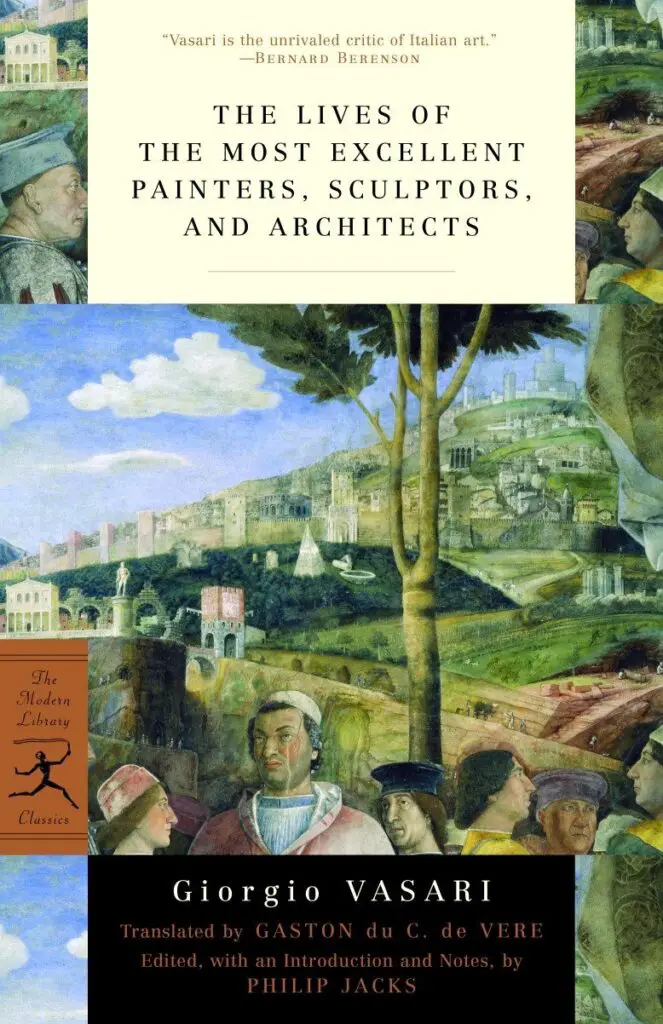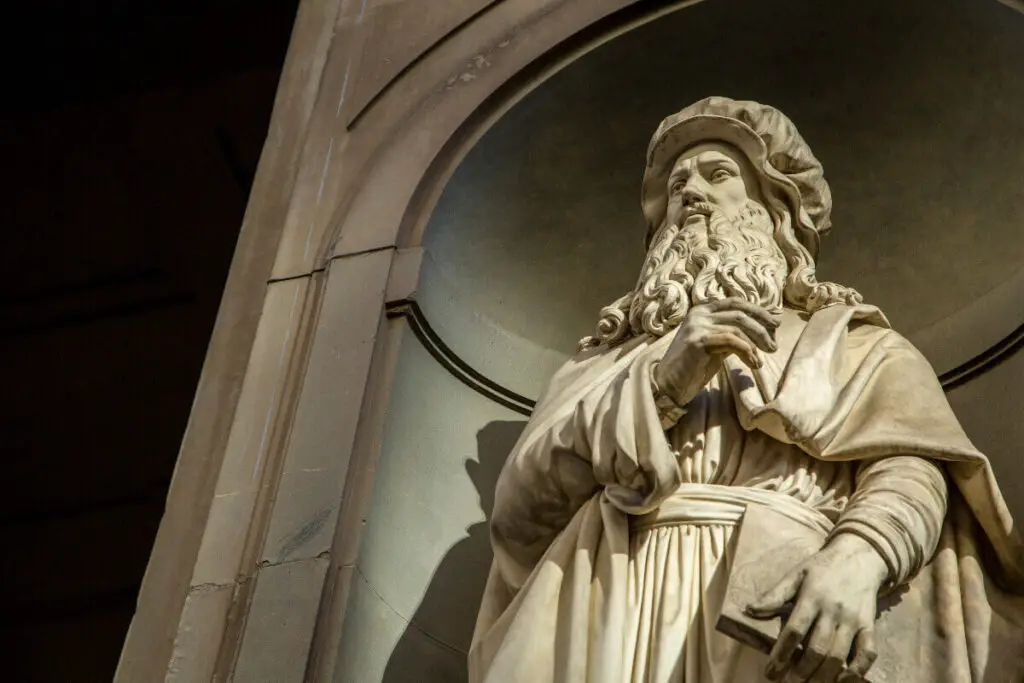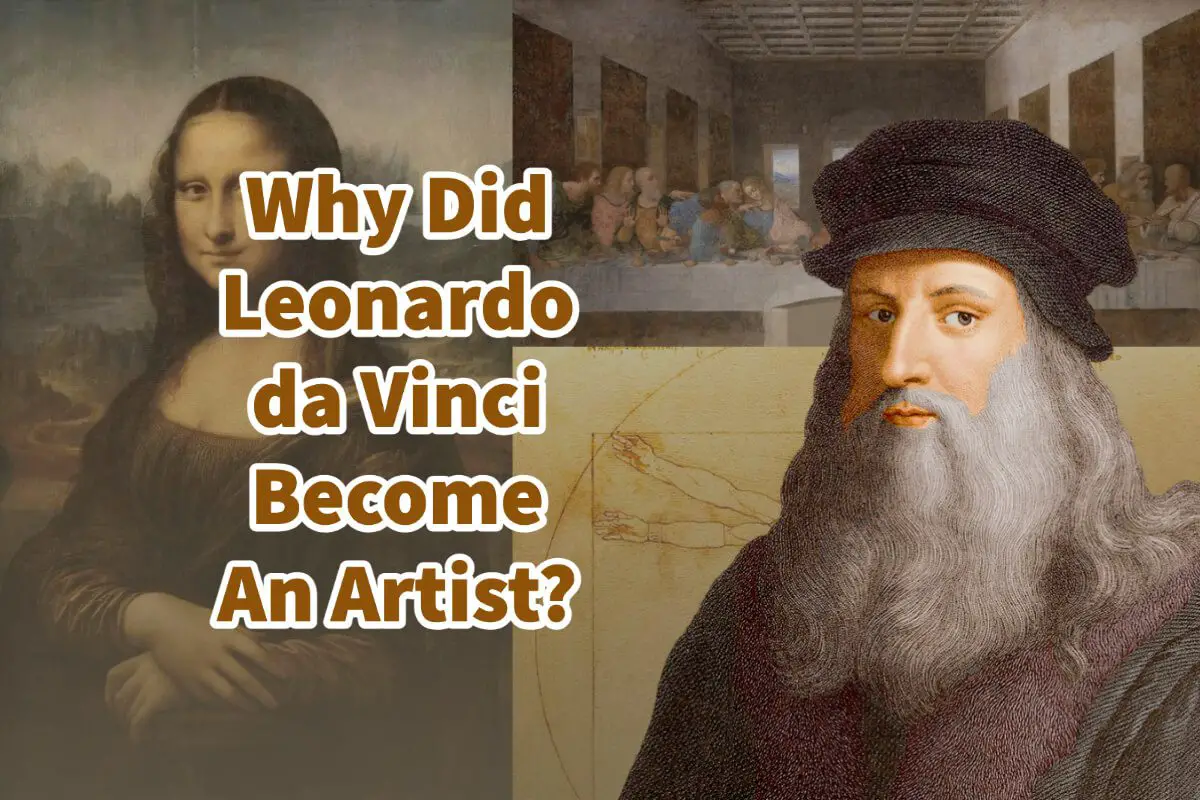Leonardo da Vinci left many notebooks with his writings. But for all the pages of writings he left, he did not tell us much about his life or thoughts.
We do not know why Leonardo da Vinci became an artist, but we do know that he was very talented and showed a disposition to the arts, even from a very young age. We also know his father helped him get into an art studio to be trained under Andrea del Verrocchio, a well-known artist in Florence, Italy.
Table of Contents
- Exploring Leonardo da Vinci’s Artistic Journey: The Path to Becoming an Artist
- Leonardo da Vinci Showed Artistic Inclinations Early In Life
- At Age 15 Leonardo Apprenticed To Andrea del Verrocchio
- Leonardo da Vinci Trained In Painting And Sculpture And Many Other Professions
- From An Early Age, Leonardo da Vinci Showed Artistic Genius
- Art Allowed Leonardo da Vinci To Study Other Subjects
- Frequently Asked Questions
- Related Questions
Exploring Leonardo da Vinci’s Artistic Journey: The Path to Becoming an Artist
Leonardo da Vinci, a polymath of the Renaissance, left an extensive legacy of notebooks filled with his writings, sketches, and ideas. Despite the wealth of information these pages offer, they reveal little about his personal life or innermost thoughts, including the reasons behind his pursuit of art.
While the precise motivations behind Leonardo’s decision to become an artist remain unclear, his early talent and inclination toward the arts were evident.
His father played a crucial role in nurturing this talent by securing him an apprenticeship in the studio of Andrea del Verrocchio, a renowned artist in Florence, Italy. This pivotal step laid the foundation for da Vinci’s remarkable journey in the world of art.
Because Leonardo da Vinci did not leave us many of his thoughts and reasons for studying art, we can learn about Leonardo da Vinci from the book “The Lives Of The Most Excellent Painters, Sculptors and Architects” by Giorgio Vasari (1511 to 1574).

Even though Vasari was younger than Leonardo, he would have known of him; this book remains a cornerstone of art history, especially in the Renaissance era.
Here are some of our top reasons and some that Vasari mentioned in his book, why Leonardo da Vinci became an artist.
Leonardo da Vinci Showed Artistic Inclinations Early In Life
Leonardo da Vinci showed that he was inclined toward art at a young age. We know he was a curious child who took it upon himself to learn many things.

Vasari spoke of how he was unstable in many of the other pursuits in life except the arts. It shows that Leonardo was a brilliant child; he is considered by many to be a genius. We learn he asked his tutors so many questions they could not answer.
As Giorgio Vasari said in his book The Lives Of The Most Excellent Painters, Sculptors, and Architects about Leonardo da Vinci and his early schooling:
“Truly marvellous and celestial was Leonardo, the son of Ser Piero da Vinci; and in learning and in the rudiments of letters he would have made great proficience, if he had not been so variable and unstable, for he set himself to learn many things, and then, after having begun them, abandoned them. Thus, in arithmetic, during the few months that he studied it, he made so much progress, that, by continually suggesting doubts and difficulties to the master who was teaching him, he would very often bewilder him. He gave some little attention to music, and quickly resolved to learn to play the lyre, as one who had by nature a spirit most lofty and full of refinement: wherefore he sang divinely to that instrument, improvising upon it.“
The Lives Of The Most Excellent painters, Sculptors, and Architects by Giorgio Vasari (1550)
At Age 15 Leonardo Apprenticed To Andrea del Verrocchio
Leonardo’s father, Ser Piero, saw that his son could not keep his attention span in almost any area except art. Leonardo showed promise in math, languages, and music, but it was the arts that he enjoyed.
Leonardo’s father approached Andrea del Verrocchio, one of the leading artists of the late 15th century in Florence, to see if Leonardo could study in his studio. At the age of 15, Leonardo went to study art at Verrocchio’s studio.
“Nevertheless, although he occupied himself with such a variety of things, he never ceased drawing and working in relief, pursuits which suited his fancy more than any other. Ser Piero, having observed this, and having considered the loftiness of his intellect, one day took some of his drawings and carried them to Andrea del Verrocchio, who was much his friend, and besought him straitly to tell him whether Leonardo, by devoting himself to drawing, would make any proficience. Andrea was astonished to see the extraordinary beginnings of Leonardo, and urged Ser Piero that he should make him study it; wherefore he arranged with Leonardo that he should enter the workshop of Andrea, which Leonardo did with the greatest willingness in the world.”
The Lives Of The Most Excellent painters, Sculptors, and Architects by Giorgio Vasari (1550
Even at 15 years old, Andrea del Verrocchio was surprised to see Leonardo’s talent. From this, we can learn that Leonardo was interested in art and wanted to train to become an artist.
Leonardo da Vinci Trained In Painting And Sculpture And Many Other Professions
Leonardo was known to not just train in one type of art but many types and kinds of art. His training was in drawing, painting, and sculpting; he started working on his inventions and architecture at a young age.
“And he practised not one branch of art only, but all those in which drawing played a part; and having an intellect so divine and marvellous that he was also an excellent geometrician, he not only worked in sculpture, making in his youth, in clay, some heads of women that are smiling, of which plaster casts are still taken, and likewise some heads of boys which appeared to have issued from the hand of a master; but in architecture, also, he made many drawings both of ground-plans and of other designs of buildings; and he was the first, although but a youth, who suggested the plan of reducing the river Arno to a navigable canal from Pisa to Florence. He made designs of flour-mills, fulling-mills, and engines, which might be driven by the force of water:”
The Lives Of The Most Excellent painters, Sculptors, and Architects by Giorgio Vasari (1550
Even at a very young age, Leonardo did not stop learning or looking at how to solve a problem. He was always looking for something to invent, change or improve.
From An Early Age, Leonardo da Vinci Showed Artistic Genius
When Leonardo studied under Andrea del Verrocchio, it must have been very humbling for Andrea del Verrocchio to have a student who could paint and execute color even better than he, as the master, could.
“…to learn art with Andrea del Verrocchio, who was making a panel-picture of S. John baptizing Christ, when Leonardo painted an angel who was holding some garments; and although he was but a lad, Leonardo executed it in such a manner that his angel was much better than the figures of Andrea; which was the reason that Andrea would never again touch colour, in disdain that a child should know more than he.“The Lives Of The Most Excellent painters, Sculptors, and Architects by Giorgio Vasari (1550
We learn from Vasari that Leonardo showed some artistic genius at a very young and early age. I believe it is because of this artistic genius and natural ability that Leonardo knew he could earn a living as an artist.
Art Allowed Leonardo da Vinci To Study Other Subjects
Leonardo da Vinci may have trained as an artist during his lifetime, but art was not his real professional interest. Leonardo was an Italian painter, draftsman, sculptor, architect, engineer, inventor, medical researcher, and scientist.
He was an individual who never tired of knowledge and was not afraid to try to invent or learn something new. Being an artist during the Renaissance allowed him to practice his art and continue researching, creating, and inventing.
“And he was continually making models and designs to show men how to remove mountains with ease, and how to bore them in order to pass from one level to another; and by means of levers, windlasses, and screws, he showed the way to raise and draw great weights, together with methods for emptying harbours, and pumps for removing water from low places, things which his brain never ceased from devising; and of these ideas and labours many drawings may be seen, scattered abroad among our craftsmen; and I myself have seen not a few.”
Leonardo did not tell us why he became an artist. Still, Giorgio Vasari, in his book The Lives Of The Most Excellent Painters, Sculptors, and Architects (1550), does help us discover some of the things that motivated Leonardo to become an artist.
Anita Louise Art is dedicated to art education, great artists, and inspiring others to find and create their art. We love art that uplifts and inspires. #ArtToMakeYouSmile! #ArtToMakeYouHappy!
If you want to see any of my art, you can find out more by clicking here. If you are interested in what inspires me and my paintings, you can discover more by clicking here.
We have a free newsletter and would love you to be part of our community; you can subscribe to the newsletter by clicking here. If you have any questions, I would be happy to talk to you. You can reach me, Anita, by clicking here.
Subscribe to our Anita Louise Art YouTube Channel filled with great videos and information by clicking here.
Join us for our podcast “5 Minutes With Art.” Spend just 5 minutes a week with us to discover and learn about great art and artists. You can find out more about our podcast by clicking here.
Frequently Asked Questions
Why did Leonardo da Vinci choose to become an artist?
Leonardo da Vinci’s inclination towards art can be traced back to his early years. While the exact motivations are unclear, his artistic talent and curiosity seem to have driven him towards a career in the arts.
What early signs or talents did Leonardo da Vinci exhibit as an artist?
Even as a young boy, Leonardo da Vinci displayed remarkable artistic skills. His early drawings and sketches showcased a natural talent for capturing details and a keen interest in observing the world around him.
Did Leonardo da Vinci receive formal art education?
Yes, Leonardo da Vinci received formal art training under the renowned artist Andrea del Verrocchio in Florence, Italy. Verrocchio’s studio provided him with a structured environment to develop his artistic skills.
How did Leonardo da Vinci’s family influence his decision to become an artist?
While specific details are limited, it is known that Leonardo’s father supported his artistic pursuits. His father’s encouragement likely played a role in facilitating his entry into the art world.
What role did Andrea del Verrocchio play in Leonardo da Vinci’s artistic development?
Andrea del Verrocchio, Leonardo’s mentor, significantly influenced his artistic growth. Under Verrocchio’s guidance, Leonardo gained exposure to various artistic techniques and developed a strong foundation for his future work.
Were there other factors besides talent that led Leonardo da Vinci to become an artist?
While talent was a crucial factor, Leonardo’s insatiable curiosity, fascination with the natural world, and a desire to explore the possibilities of art and science likely contributed to his decision to become an artist.
Did Leonardo da Vinci express his reasons for pursuing art in his writings?
Leonardo’s extensive notebooks contain a wealth of information, but he did not explicitly delve into his personal motivations for choosing art. The notebooks primarily document his observations, ideas, and scientific inquiries.
How did the cultural and artistic atmosphere of Renaissance Florence influence Leonardo da Vinci’s choice of profession?
The vibrant artistic and intellectual environment of Renaissance Florence, where great minds converged, likely played a role in shaping Leonardo’s artistic ambitions. The city’s cultural richness may have inspired him to pursue a career in the arts.
Related Questions
How Was Leonardo da Vinci Able To Master So Many Different Professions?
Leonardo da Vinci is a man known to have had many different titles and professions during his lifetime. He was able to master this profession because he was a genius. But more than just being a genius, Leonardo is also self-educating and never stops learning. He had an insatiable amount of curiosity about all kinds of subjects.
By clicking here, you can learn more by reading How Was Leonardo da Vinci Able To Master So Many Different Professions?.
What Can We Learn From Leonardo Da Vinci?
Leonardo da Vinci was a philosopher; being a philosopher means that you want to seek wisdom. Leonardo was one person who tried to seek knowledge or enlightenment in his life. Leonardo was an active observer and learner of the human body, human behavior, and nature.
By clicking here, you can learn more by reading What Can We Learn From Leonardo Da Vinci?.
Was Leonardo da Vinci A Philosopher?
Leonardo da Vinci was a philosopher; being a philosopher means that you want to seek wisdom. Leonardo was one person who wanted to seek wisdom or enlightenment in his life. Leonardo was an active observer and learner of the human body, human behavior, and nature.
By clicking here, you can learn more by reading Was Leonardo da Vinci A Philosopher?.


